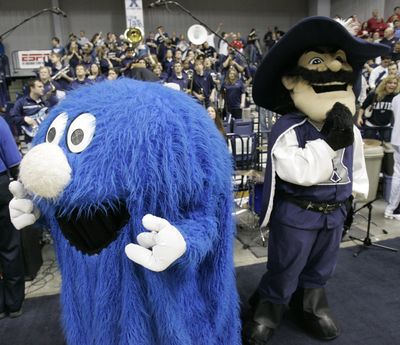Mascots love their job, but it stinks

CINCINNATI – Clumps of Abby Strietmann’s red hair cling to her forehead as she slips out the zippered back of her Blue Blob mascot costume. She slides her 5-foot-1, 125-pound frame wearily to the floor and leans her sweat-soaked back against a cinderblock wall.
Ah, a little cool air.
Xavier’s nationally ranked basketball team has just dashed off the court for halftime. With a double-digit lead, the Musketeers would probably rather keep playing.
Not Strietmann. She needs this timeout.
“This is warmer than normal,” she said, sticking out her tongue. “Still, it’s a lot of fun. I love it.”
She has plenty of sweaty company now that it’s tournament time.
Hundreds of college students are climbing into costumes of blobs and Billikens, panthers and peacocks, demon deacons and founding fathers, and heading to far-flung arenas for their own version of March madness.
Like the players, they are fit, they vie for a competitive job, and some even get all their tuition paid.
They’re at center court for the best moments of the season – and some of the most grueling, given that teams can play on three or four consecutive days in conference tournaments.
Consider the Hawk, mascot at Saint Joseph’s in Philadelphia: As he roams the arena floor, tradition dictates that he also flap his wings during games. Constantly.
The further his team advances, the more the Hawk starts to stink like he’s been at the gym for days with no shower.
“All our coaches always joke with me about how bad I smell,” said Tim Klarich, the current Hawk.
But like Strietmann, who will accompany Xavier’s women at the NCAA tournament, students consider it the coolest thing they’ve ever done.
“It opens opportunities that normal college kids don’t usually have access to,” said Steve Klarich, Tim’s older brother, who was the Hawk from 2001-03.
Tim Klarich called it “the next best thing to playing.”
Just like the athletes, mascot candidates have to make it through demanding tryouts. They must be able to handle an intense cardiovascular workout in a bulky, heat-retaining costume.
Nobody just walks off the street to become an eagle or an anteater – at least not usually – although there’s the occasional understudy-becomes-star story.
Tennessee coach Bruce Pearl was an administrative assistant at Boston College in 1981, when the Eagles made the NCAA tournament. The mascot got sick, so Pearl was ordered to put on the beak. He took the role to heart, doing everything he could to distract the Ball State players, even using a ladder behind the basket to wave obnoxiously during free throws.
“They had a meeting after the game and they were going to throw me out. I broke like five NCAA rules,” Pearl joked.
There are specific requirements for how those in costume do their jobs. For instance, all Brutus Buckeye mascots at Ohio State are trained to move and pose alike.
“You walk with a purpose,” said senior Andrew Aten, one of five Brutuses this year. “You walk with clenched fists. Your arms are kind of slightly bent. Whenever you’re standing, it’s in a strong posture. That’s our persona.”
Mascots of both feather and fur agree the most difficult part of the job is the costume, which sometimes can be unbelievably awkward. Vision is limited through the eye holes – like looking through a mesh-covered periscope.
The most unpleasant part?
There’s no delicate way to put it: After absorbing about 10 pounds of sweat each game, the costume really stinks. Fabric sprays and dry cleaning don’t help. Mostly, the students just get used to the smell.
Costumes, which can cost thousands of dollars, get careful treatment. The Nittany Lion outfits at Penn State have been handmade by a local tailor for about 20 years. When a feather falls from The Hawk during a game, it’s quickly collected.
Mascots also must be on their best behavior, because they are one of the school’s most visible representatives. Sometimes, strange things happen anyway.
At a women’s NCAA tournament game in 2006, the Stanford tree – the school’s unofficial mascot – was ejected for not leaving the court fast enough after halftime. At the men’s 1994 Final Four, Arizona’s wildcat mascot got tangled with Arkansas’ razorback – a red, furry pig – resulting in a knee injury and a lawsuit.
A more common challenge is keeping up with classes. Like players, mascots also feel the pressure at tournament time.
“It can be pretty exhausting,” said Ohio State’s Aten, a biology/premed major who had to study for exams on immunobiology and Greek art and archaeology, and write a paper on global organ trafficking. “You have to figure out when you’re going to type papers or study between games.”
There also are perks.
Some schools give their mascots stipends. The Hawk at Saint Joseph’s gets tuition covered – a $32,710 benefit for his dual role as team manager and mascot. Penn State’s Nittany Lion also gets a free ride.
Some even turn their mascot days into careers, going on to fill costumes for professional teams.
And like every player, they dream of making the Final Four.
Jason Zicchino got to do it in 2000, filling the role of Sparty while Michigan State beat Florida to win the national championship. The experience overwhelmed him.
“I just tried to take a step back for every game and appreciate the moment,” said Zicchino, who works in the insurance industry in Texas. “By the time we got to the national championship game, I was in tears. I was crying in the last three minutes of the game.”
Every mascot would love to get the costume wet that way.